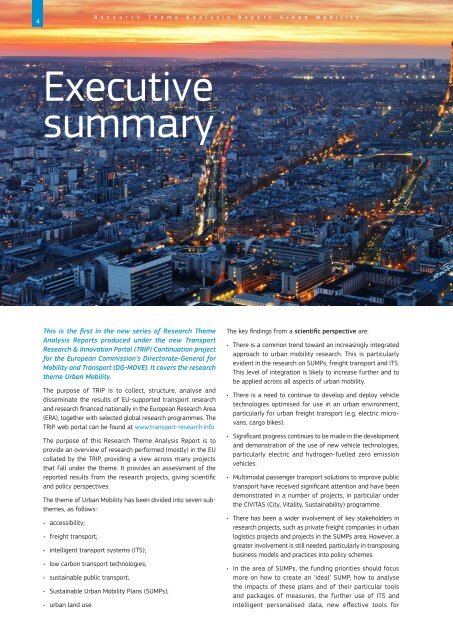Research Theme Analysis Report Urban Mobility
TRIP_Urban_Mobility_brochure-12.04.2016.pdf?utm_content=buffer91143&utm_medium=social&utm_source=twitter
TRIP_Urban_Mobility_brochure-12.04.2016.pdf?utm_content=buffer91143&utm_medium=social&utm_source=twitter
You also want an ePaper? Increase the reach of your titles
YUMPU automatically turns print PDFs into web optimized ePapers that Google loves.
4<br />
R e s e a r c h T h e m e A n a l y s i s R e p o r t U r b a n M o b i l i t y<br />
Executive<br />
summary<br />
This is the first in the new series of <strong>Research</strong> <strong>Theme</strong><br />
<strong>Analysis</strong> <strong>Report</strong>s produced under the new Transport<br />
<strong>Research</strong> & Innovation Portal (TRIP) Continuation project<br />
for the European Commission’s Directorate-General for<br />
<strong>Mobility</strong> and Transport (DG-MOVE). It covers the research<br />
theme <strong>Urban</strong> <strong>Mobility</strong>.<br />
The purpose of TRIP is to collect, structure, analyse and<br />
disseminate the results of EU-supported transport research<br />
and research financed nationally in the European <strong>Research</strong> Area<br />
(ERA), together with selected global research programmes. The<br />
TRIP web portal can be found at www.transport-research.info<br />
The purpose of this <strong>Research</strong> <strong>Theme</strong> <strong>Analysis</strong> <strong>Report</strong> is to<br />
provide an overview of research performed (mostly) in the EU<br />
collated by the TRIP, providing a view across many projects<br />
that fall under the theme. It provides an assessment of the<br />
reported results from the research projects, giving scientific<br />
and policy perspectives.<br />
The theme of <strong>Urban</strong> <strong>Mobility</strong> has been divided into seven subthemes,<br />
as follows:<br />
• accessibility;<br />
• freight transport;<br />
• intelligent transport systems (ITS);<br />
• low carbon transport technologies;<br />
• sustainable public transport;<br />
• Sustainable <strong>Urban</strong> <strong>Mobility</strong> Plans (SUMPs);<br />
• urban land use.<br />
The key findings from a scientific perspective are:<br />
• There is a common trend toward an increasingly integrated<br />
approach to urban mobility research. This is particularly<br />
evident in the research on SUMPs, freight transport and ITS.<br />
This level of integration is likely to increase further and to<br />
be applied across all aspects of urban mobility.<br />
• There is a need to continue to develop and deploy vehicle<br />
technologies optimised for use in an urban environment,<br />
particularly for urban freight transport (e.g. electric microvans,<br />
cargo bikes).<br />
• Significant progress continues to be made in the development<br />
and demonstration of the use of new vehicle technologies,<br />
particularly electric and hydrogen-fuelled zero emission<br />
vehicles.<br />
• Multimodal passenger transport solutions to improve public<br />
transport have received significant attention and have been<br />
demonstrated in a number of projects, in particular under<br />
the CIVITAS (City, Vitality, Sustainability) programme.<br />
• There has been a wider involvement of key stakeholders in<br />
research projects, such as private freight companies in urban<br />
logistics projects and projects in the SUMPs area. However, a<br />
greater involvement is still needed, particularly in transposing<br />
business models and practices into policy schemes.<br />
• In the area of SUMPs, the funding priorities should focus<br />
more on how to create an ‘ideal’ SUMP, how to analyse<br />
the impacts of these plans and of their particular tools<br />
and packages of measures, the further use of ITS and<br />
intelligent personalised data, new effective tools for


